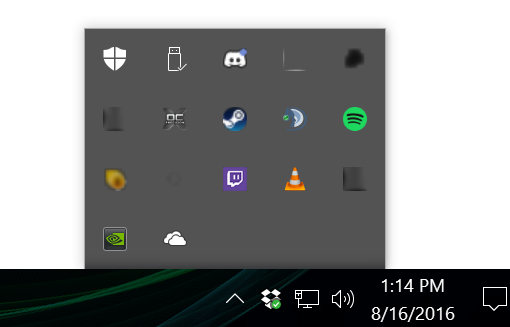Usually when you minimize a program or app, it goes to the taskbar. This gives you quick access when you need to maximize it. But sometimes you don’t need a program cluttering up your taskbar when it just needs to run in the background, such as when you’re downloading files in your browser. That’s when it’s a good idea to send Windows 10 programs to the system tray instead.
While some programs have this option by default, many don’t. Several third-party tools let you send any Windows 10 program directly the system tray using the minimize option or a hotkey. This is also a great way to quickly hide running programs from prying eyes.
Minimize to Tray
One of the most commonly used tools to send Windows 10 programs to the system tray is Minimize to Tray. As the name implies, it minimizes apps to the system tray.

However, it doesn’t use the minimize button in the program’s window. Instead, it’s even easier, which is what makes it a popular choice. To send an active open window to the system tray and remove it from the taskbar, press Alt + F1, then press Alt + F2 to restore the last minimized window.
Alternatively, if you want to restore all your minimized system tray windows at once, press F10. You can change these hotkeys if you want by clicking the Minimize To Tray icon in your system tray. You’ll also see a list of all currently minimized windows. This is a great app to ensure no one sees an open window if you don’t want them to, as the icons aren’t even visible in your system tray.
The tool is completely free and regularly updated. While I tested it on Windows 10, it does work on Windows 7 and 8 too.
Traymond
Traymond is one of the simplest apps to send Windows 10 programs to the system tray. It’s a portable program, has no settings, and erases any stored data when you close the app or restart your computer. If you want a third-party tool that doesn’t leave any real trace behind, Traymond is a great choice.

Traymond is easy to use, as there’s only one hotkey combo to remember. When any window is open, press Win + Shift + Z to minimize the window to the system tray. The program’s icon does show up in the tray.
To maximize the window and return it to the taskbar, double-click the program’s icon in the system tray. You can also right-click the Traymond icon in your system tray and choose “Restore All Windows” if you want to maximize multiple windows at once.
Actual Window Minimizer
As the only premium option on the list, Actual Window Minimizer also works a little differently from the rest. Instead of a hotkey, this tool adds a new minimize option to every Windows 10 app window. This doesn’t replace your existing minimize icon.

Instead, a smaller minimize icon is placed beside the standard one. With a single click, you can send any app directly to the system tray. While the icon does appear in the tray, it’s not visible unless you expand the system tray to show all icons.
Since the app does cost $19.95 and only provides free updates for a year, it does offer additional customization options. You can configure Actual Window Minimizer to use hotkeys, change the minimize mode and how to restore windows, and much more. It’s a much beefier option if you want more control and like the idea of having the minimize option in your Windows 10 program’s window.
There’s a 14-day free trial to see if you like the tool before you buy.
RBTray
RBTray takes a slightly different approach in sending Windows 10 programs to the system tray. There aren’t any hotkeys or new icons added. In fact, you won’t even see an RBTray icon in your system tray. Instead, double-click the app to start running it in the background. It’s a portable app and doesn’t install anything.
Then, right-click the minimize button in any window to instantly minimize it to the system tray. When you want it back, click the minimized app’s icon to maximize it and return it to the taskbar. It’s a simple, small, and highly effective tool.
It hasn’t been updated in a while, but it did work on Windows 10 in my own tests for browsers, folders, Office files, and more.

Comments
Post a Comment